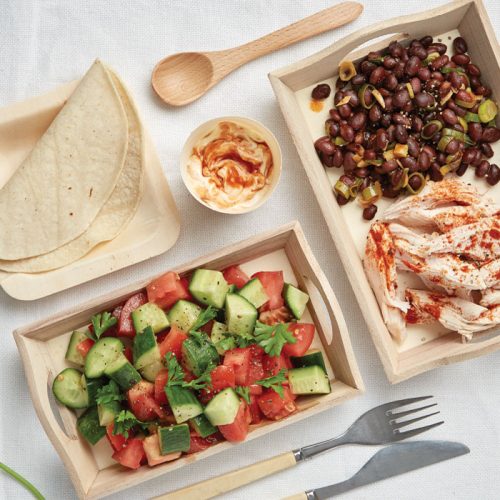
Keen to get the whole family eating better and living healthier? It can be done! Deb Tapp talks to the experts and shares their advice for a family health makeover.
It’s common knowledge that unhealthy food is more heavily promoted, more accessible and usually cheaper than healthy food. It’s also well-known that childhood obesity is on the rise, with one in five children aged two to 14 years now overweight. Then there’s the fact that healthy eating behaviours tend to decline with increasing age.
But it’s not all doom and gloom — habits can be changed for the better if families rally together to develop a positive relationship with healthy food in a supportive environment.
As Wellington nutritionist and dietitian Sarah Elliott says, one of the most important things to remember is to focus on healthy habits, not weight.
“Forget the scales and don’t comment on people’s shape or weight. Instead, focus on eating more fresh produce, regular family fun activity and look at other ways everyone can benefit by highlighting things like improvements to energy levels and quality of sleep.”
Get everyone on board
Before venturing down the healthy habits path, appoint one parent as ‘project manager’ and ensure every adult in the house is willing to lead by example — it’s unlikely children will eat Brussels sprouts if you won’t go near them.
Get together as a family and discuss exactly what you are going to do and how you are going to go about it. Lay down some ground rules. Remember: children are often more rigid in their thinking and sticking to the rules than adults — they seem to like nothing more than pointing out an adult is not doing it right or breaking the rules!
“Parents are important role models for children, so show your children how to make small realistic changes you know you and the family can stick with, rather than a rigid diet,” says Elliott.
Enthusiasm rubs off on children, she says, and using the right terminology is vital. Don’t say: “I guess we should do this”. Use positive language such as: “It’d be great if we do this”.
And don’t create a battleground or any forcefulness or pressure, says Elliott, because children will simply respond in the opposite manner.
Don’t restrict or ban food. Instead talk about healthy options and encourage your family to choose fruits, vegetables, whole grains, lean meats, and low-fat dairy, while avoiding junk foods.
Relate foods to the things your children — especially teenagers — care about, such as sports or doing well at school. Let them know that lean protein such as red meat, chicken, fish and calcium in dairy products give them strength for sports, that antioxidants in vegetables and fruit add lustre to skin and hair, and eating a healthy breakfast can help them concentrate in class.
Make some goals
Make small but realistic changes. Pick a few simple goals — say two each week.
Eating takeaways once a week is realistic for families who eat out three times a week. Once a fortnight is ideal.
Both Sarah Elliott and Wellington GP Ciandra Keenan agree that another important move is to eat together or at least sit down with children when they are eating. Try to make it a family time to catch up on the day’s activities.
“Research clearly shows people eat more if they’re distracted — between 10-50 per cent more. Research also shows that children who eat dinners at the table with their parents have better nutrition and show signs of improved behaviour,” say Keenan and Elliott.
Check lunchboxes have a variety of healthier food choices: replace high-sugar foods with carrots, homemade muffins, popcorn, crackers, low-fat cheese, pretzels and fruit.
Look at the family’s snack consumption. Is this something to change? Children eat when they are hungry but most don’t need to eat all the time. If they are full on other things, they are not going to eat vegetables at dinner.
Trying a new recipe each week is another achievable goal, as is tasting a new vegetable or fruit. Make sure you serve other familiar foods at the same time. If your child has a friend who is an adventurous eater, they may be more likely to try a new food if they are present.
Make time to have breakfast every day as it fuels your metabolism and is important for brain function. Try to steer clear of sugary cereals. Opt instead for wholegrain toast with topping, eggs, baked beans or cereals or muesli.
Change your family’s drinks to water or milk. Save juice, fizzy drinks and cordial for special occasions — no more than once a week.
Another good goal is to exercise for 30 minutes a day, preferably as a family.
Make the challenge fun
Shopping together is a great idea if you have time. Let children choose vegetables and fruit at the supermarket, and read the labels to look at the fat and sugar content. Older children could budget and compare costs.
Get children to help put together their lunches and take responsibility for choosing, preparing or making a meal. If they have a sense of ownership, they are more likely to eat it. For example, they could wash or peel veges, stir/mix foods or simply tear lettuce leaves or break eggs. Older children could have a night to cook each week.
Baking with your children on the weekend for their school lunches is a good way to save money and reduce packaging, and it’s a fun activity that teaches them skills for life.
Have charts or graphs on the fridge which you can tick or use stickers once a goal has been achieved. For fun initiative ideas go to www.vegetables.co.nz or www.5aday.co.nz.
Use rewards for family achievement such as an outing, movie, zoo trip or a hired DVD. Children come up with all sorts of odd rewards they think are fun, like Dad being the focus for a water fight. Never use food as a reward.
Sticking to it
It is possible to make these new-found habits permanent. Check in with your goals on the first week of each month. If they have slipped, make the effort to get back on track, or you may need to re-evaluate and change your goals. Even when weight-loss will be a result of getting healthier, focus on the behaviour changes, not the weight. Habits are more likely to stick if you praise family members when they choose healthy foods such as vegetables, fruits, whole grains or low-fat dairy products.
Success will also come if you make sure healthy food is always on hand. It’s human nature to eat what’s available, so keep fruit in a bowl that’s easily accessible rather than buried in the fridge.
If you’ve achieved a goal, embrace new ideas and set new goals. Make both short and long-term goals, keeping them realistic.
And if stress levels, sickness or tiredness cause new habits to regress, don’t be disheartened.
“People tend to go back to their default setting when any of those three things happen, but to stay on track all they may need to do is simply plan their meals each week and keep the fruit bowl stocked,” says Elliott.
Remember, little changes now will result in long-term gains — creating an environment where your family makes healthy nutritional choices is one of the most important steps to ensure their health, and yours.
“By making over your family’s health, you’re helping to set up eating preferences for life, you’re giving your children a really important gift by teaching them to appreciate a wide range of nutritious food, so get creative and get tasty,” says Elliott.
How to get the family moving
Exercising as a family is a fun way to spend quality time together. Fitness trainer Mish McCormack has some ideas for the whole family to get active and have fun at the same time:
- Throw a frisbee in the backyard or at your local park
- Jump on a trampoline in the backyard
- Explore your local suburb while out walking the dog
- Kick a rugby or soccer ball around or play cricket or volleyball in the backyard, a park or at the beach
- Ride bikes along cycle tracks
- Swim and splash around at the pool
- Go on a walking adventure on well-marked tracks
- Scooter, rollerskate, rollerblade or skateboard in a suitable vacant public space
- Make gardening, washing the house or washing the car a family activity
- Get everyone involved in other household chores such as mowing the lawns, cleaning the windows or sweeping the driveway
- Fly a kite in your backyard, at the park or beach.
Cut the screen time for a healthier family
The figures make for grim reading: too much screen time in childhood and adolescence is linked to obesity, poor fitness, smoking and raised cholesterol in adulthood.
More than half of children still watch more than the recommended two hours maximum
of TV/screen time each day.
The SWITCH study team based at the University of Auckland are trialling methods to cut back on screen time with 250 Auckland families.
Researchers’ tips to cut down on screen time
- Break the habit of your child coming home from school and watching TV or using the computer by introducing a rule that gives them a break from screen time. For example, once home, encourage your child to have a snack then to do an activity other than watch TV for half an hour — there are plenty of fun alternatives.
- Cut down on screen time gradually. Decrease their time by 10 per cent each week, compared to their usual amount, and keep reducing it by 10 per cent each week.
- Discuss and agree on a ‘screen time’ budget with your child. Plan their screen time for the week to ensure they don’t go over the budget — it will help them to ‘buy in’ to the idea of having a budget and may help them stick to it. Display the budget in a visible place such as on the fridge.
- Involve the whole family. It will be hard for your child to stay away from TV if the rest of the family is watching it.
- Remove TV or video games from your child’s bedroom. Put video games in hard-to-reach places.
- Hang a sign over the TV during non-TV time. Make sure there are toys on hand, or an area set up where your child has everything they need to do their homework.
- Eat together as a family without the TV on. Many families use the TV for background noise even though they are not really watching it.
- Be a positive role model. Turn off the TV at night yourself and read instead, and encourage older siblings to play with younger siblings rather than play video games.
- Reward your child for their desired behaviour. A reward can be as simple as praise (“I am so proud of you for finding other things to do than watch TV, great stuff”), going outside and playing catch or going on a family outing. Reward will encourage more good behaviour.
www.healthyfood.com










